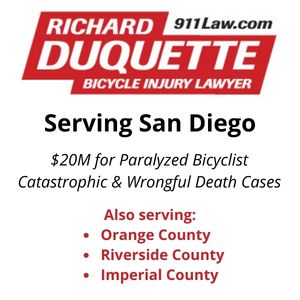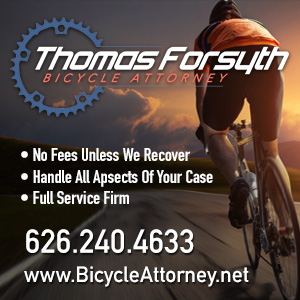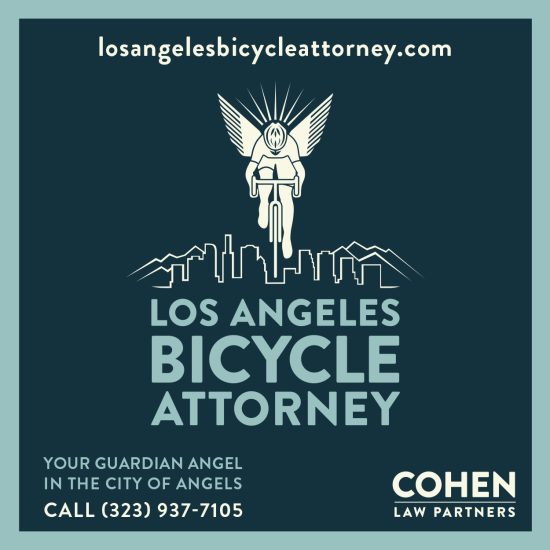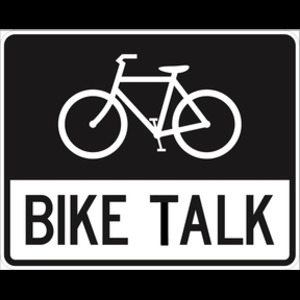One of the big problems cyclists — as well as other L.A. residents and visitors — face around here is that the things that should be our greatest assets are often virtually unusable due to a lack of planning and/or maintenance.
From a pedestrian-choked beachfront bike path to a proposed bike boulevard rutted with potholes and misplaced bike routes that thrust unknowing riders onto streets most cyclists choose to ignore, too many areas in this city fall far short of what they could be. And should be. Yet in most cases, it would only take a little effort and minimal investment to correct the problems.
Today, Patrick Pascal, cyclist, Downtown professional and fellow founding member of the League of Bicycling Voters LA — and yes, the LBVLA is still alive and preparing to play a role in next year’s council elections — joins Ross, Zeke, Damien and Eric in stepping into my shoes for a day with a guest post on riding in Griffith Park, and how it can be improved to benefit everyone.
.………
Griffith Park from a Cyclist’s Perspective
Griffith Park, despite increasing urban encroachment, remains a remarkable oasis of tranquility within central Los Angeles. To preserve the already low level of park space within the City, citizens must be vigilant in protecting existing places like Griffith Park. Minor improvements and changes to Park policies and infrastructure can both ensure and increase this tranquility for many more years.
Like many aspects of Los Angeles’ management, Griffith Park demonstrates a disconnect between purpose and policy. Most can generally agree that the purpose of the Park is to provide a welcoming and bucolic setting where Angelinos can safely enjoy a variety of physical, recreational and social activities. Below, specific policies that are contrary to the purpose of the park which demonstrate this disconnect between purpose and policy are identified along with potential remedies.
Is it a Park or a Thoroughfare?
Park roads should only be used by and designed to accommodate Park patrons. Speed limits are presently so high that they encourage commuters to bypass the (5) Freeway during traffic periods, which undermines the safety, atmosphere and the infrastructure of the Park. The speed limit inside Griffith Park should be at a speed that considers the many (non-auto) recreational users who are present. A strictly-enforced limit of 20 miles/hour would keep nearly all Park attractions within 5 minutes of an entry point, while making the Park safer, quieter, less-crowded and cleaner. There is simply no park-centric reason for a higher speed limit.
Park Access by Bicycle
By encouraging patrons to come by bicycle, Griffith Park could accommodate more visitors with a lower impact. An entire family should be able to safely ride their bicycles to Griffith Park from most parts of the city, however, at present, it isn’t even safe from adjoining Los Feliz or Atwater. A family should be able to safely use the Griffith Park Blvd Bike Lane to reach the Park and a family should be able to safely use the Los Angeles River Bike Path to reach the Park, but neither of these routes safely accesses the Park. They both again demonstrate the basically deficient policies that do not consider actual purpose—the paths themselves don’t really go anywhere.
Take the Griffith Park Blvd Bike Lane. After coming north from Sunset Blvd for over two miles (don’t get me started on the condition of the roadbed), the bike lane abruptly ends just 50 yards short of Los Feliz Blvd. Putting a bike lane where there is a need and plenty of room is appreciated, but easy. Abandoning a rider, just when a lane is most needed, gives the rider little opportunity to react and adapt before the busy intersection. The bike Lane should be merged into the middle traffic lane to cross Los Feliz Blvd and on to the northern terminus of Griffith Park Blvd.
At the end of Griffith Park Blvd. the roadbed of the original street (which once continued under what is now the (5) Freeway) remains, extending to Griffith Park Drive within the Park (see above). This abandoned right-of-way has been used by pedestrians and bicycles for decades. It would take little effort to install a safe, sanctioned access way for these few yards. Making these two minor improvements would, for the first time, link the core of Los Angeles with a safe bike route all the way to its most important park.
Recently the city dedicated the southern portion of the Los Angeles River Bike Path which will now make it easier for bicyclists from southern Atwater, Highland Park and beyond to come to Griffith Park. Many other residents along the path can easily avail themselves to this option to reach the Park. Remarkably, despite passing within 50 yards from the Park for about four miles, not one of the four possible entry points can be considered reliably safe. From north to south the following conditions face riders:
- Riverside Drive at the north terminus of Bike Path. From the end of the River Bike Path to the bike lane within the Park the distance is less than 75 yards. However this ride entails a left turn across a shoulder-less, 4-lane, high-speed roadway and across busy on and off-ramps to the 134 Freeway, two stop signs and another left turn at a busy intersection—all within 75 yards. This entrance is particularly unsafe during traffic hours.
- Zoo Drive. This is probably this safest route on which to enter the park. A few signs and markings could make it the preferred entry for safety minded bicyclists. The entry/exit gate is narrow, with a small sign so riders must pay close attention. Zoo Drive has single, wide lanes with ample room for both auto and bicycle traffic. There are still two on-ramps for the (5) Freeway with which to contend, but they are not as busy as the others and cars tend to travel at lower speeds. The bridge over the freeway may provide the biggest hill to climb of the whole ride. If the DOT and Park Dept were more serious about safety, they would make this the preferred, designated and marked route between the park and the bike path. It is not the most convenient entry point, but it is the best one for those considering safety alone.
- Los Feliz Blvd. This is the most dangerous route between the Bike Path and the Park. Both exits from the Path are hard upon either a freeway on or off-ramp. My experience suggests that the closer a driver is to a freeway, the more (s)he drives as if already on the freeway and Los Feliz Blvd. is a good example of the behavior. After negotiating across those ramps, each side of the road has two more ramps which propel traffic onto busy Los Feliz blvd at a dangerous speed. Los Feliz Blvd itself is another shoulder-less road with six lanes of speeding cars that do not afford safe bicycling.
- Lastly, is the bicycle/pedestrian bridge, over the (5) Freeway from the River Bike Path, and into the Park near the tennis courts and soccer field south of Los Feliz Blvd. At the park side landing of the bridge walkers and pedestrians are met with 75 yards of a fenced off, dirt path before reaching any paving. In the summer the path is dry and dusty, but in the winter it is often muddy and sometimes impassible.
Use of Existing Assets
Except in front of the Greek Theatre and around the Zoo, all roadways within Griffith Park are single lane. However, the north-south route across the Park along the (5) Freeway from Los Feliz Blvd to the golf courses is comprised of a two-lane, one-way, northbound Crystal Springs Drive and a two-lane, one-way, southbound Griffith Park Drive. The present configuration allots a total of 44’ of width for cars, and 18’ to be shared by walkers, runners, horses and bicyclists. The purpose of Griffith Park is not to serve as an alternate route for harried commuters, but this two-lane, one-way design encourages commuters to speed through Griffith Park as an alternate to a busy freeway.
For the past year Crystal Springs Drive has been closed for major water-works and all traffic has been diverted onto just Griffith Park Drive which now handles all auto and bicycle traffic. Despite this 50% reduction in automobile capacity and narrowing of bicycle lanes, traffic has not been heavy or slowed. Before reopening Crystal Springs Drive to traffic configured as before, consider restoring it as a two-way, single-lane roadway without a bike lane; make the dirt trail along Crystal Springs Drive’s east side a “horses only” trail (no pedestrians) and; close Griffith Park Drive, north of Los Feliz Blvd, to automobiles altogether. Split the newly-closed, segregated roadbed into dedicated bike, running and walking paths with benches, water and picnic amenities. Only the entrance to the Tregnan Golf Academy would need anything but cosmetic alterations. These small, inexpensive changes would greatly add to the easily accessible areas that can be used by recreational Park patrons and further reduce the city’s footprint in the Park.
Mt Hollywood Drive north of Observatory
For a number of years Mount Hollywood Drive, which runs from behind the Observatory (just north of the tunnel) over the top of Mount Hollywood and down into the San Fernando Valley, has been closed to cars. It is one of the few hill-routes bicyclists can ride without concern for cars. Recently, the condition of the roadbed has become a bigger concern than any auto traffic could pose. Present conditions are such that patching and other cosmetics now could extend the useful life of the surface, but if this roadway continues to be neglected, it will soon be impassible and expensive to restore. If the Park is here to provide a welcoming and bucolic setting where Angelinos can safely enjoy a variety of physical and recreational activities, it should be policy to invest the small sum needed to maintain this route.
The four broad improvements listed above could all be realized at very little cost and with great benefit to all Park users—not just cyclists. They offer a low bar by which to judge the City’s commitment to providing constituent friendly amenities. While many of these efforts may appear bicycle-centric, they will improve the quality and experience of the park for all users. More patrons choosing bikes on which to visit the Park means more available parking, less traffic, less pollution, less noise, and a better utilized park for all. They do not threaten non-bike-riding park users, instead, bicycle riders represent elemental and environmental changes that all users can enjoy and embrace.
.………
A cyclist was rescued from the rain-swollen L.A. River after slipping off the bike path and falling into the water. Bicycle fixation interviews LADOT Bicycle Coordinator Michelle Mowery about the planned 4th Street Bike Boulevard, among other issues. Hearings are coming up next month for the South Bay Bicycle Master Plan. Do your part to help stop bike thieves in Venice. The Valley News profiles Peter Zupan, the Lake Elsinore native killed while riding his bike to collect recyclables last September. Phil Wood, founder of Ten Speed Press died over the weekend; his first title was Anybody’s Bike Book, the bible for all home bike mechanics in the ‘70s and ‘80s — I still have my copy on my bookshelf.
As if ex-former Tour de France champ Floyd Landis didn’t have enough credibility problems, now comes word he wore a wire in a meeting with Michael Ball, owner of the Rock Racing pro team. The Lovely Bicycle looks at the safety frame, resulting in a truly lovely bike. Arizona’s great Tucson Velo website asks if our roads are really a matter of us vs. them. An 18-year old Hawaiian cyclist is killed in a hit-and-run, while riding at the head of a group of 35 riders. A masked man yells a racial slur at a Seattle-area cyclist before chasing down and punching him, while a cyclist gets egged in Denton, Texas (home to the world’s best nuevo polka band.) Sometimes riding is a melancholy experience, even if you don’t get egged or punched. Now this is more like it, as a driver gets 36 years for killing a cyclist; then again, he did use a gun instead of a car. The founder of Design Within Reach is recreating his life as the head of Public Bikes. How to encourage the great mass of potential cyclists.
After barely surviving a collision with a drunk driver, a recuperating cyclist faces discharge from the Navy. Motorists come to the rescue of a severely injured cyclist in Australia. Converting car parking to bike parking.
Finally, if bikes get their own lane, why not build one for everyone — except drivers.


















